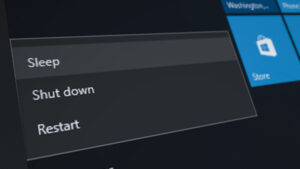Fix: Computer Won’t Stay in Sleep Mode
Several Windows users are reporting that their computer is suddenly waking up from sleep with no apparent trigger. The issue is most frequently reported on Windows 8 and Windows 10 with widely different PC configurations. As it turns out, there are numerous people having this particular problem and most of the time the issue is reported to occur after the user has installed a pending Windows update.

What is causing PC’s to Wake up from sleep?
We investigated this particular issue by looking at various user reports and the repair strategies that are commonly being used to resolve this particular issue. Based on our investigations, there are several different potential culprits that might end up causing this particular problem:
- Wake timers are enabled – This issue can occur if Important Wake timers are allowed to disrupt your sleep or hibernation sessions. If this scenario is applicable, you can resolve the issue by disabling wake timers from your Power Options menu.
- The network adapter is waking your PC from sleep – If you’re using a wired connection, chances are your network adapter is the culprit responsible for waking your PC from sleep. If this scenario is applicable, you can resolve the issue by accessing your Power Management tab and disallowing the network adapter from waking your computer.
- A Disk Defragmenter scheduled task is waking your computer – Another potential culprit that might trigger this issue is an automated Disk Defragmenter task. In this case, you can resolve the issue by disabling the automated task from the Disk Defragmenter menu.
- A connected device is waking the computer – Mouses and wireless keyboards are often responsible for this particular issue. If this is what’s causing the sudden waking periods, you can resolve the issue by identifying and restricting the device that is causing the problem.
- Wake on Magic Packet and Wake On Pattern Match – There are two Network Adapter properties (Wake On Magic Packet and Wake on Pattern Match) that might end up triggering this particular issue. In this case, you can visit your Network & sharing center settings and disable the two properties from affecting the sleep sequence.
If you’re currently struggling to resolve the same problem, this article will give you some troubleshooting ideas. Down below, you’ll find a collection of methods that other users in a similar situation have successfully used to fix the problem and stop their computers from waking out of sleep with no apparent trigger.
Method 1: Disabling Wake Timers
Some affected users have reported that they finally managed to resolve the issue after disabling Wake Timers from the advanced Sleep options. A wake timer is a timed event that wakes the PC from sleep or hibernation mode (at a specific time).
By default, a PC is configured to only allow Important wake timers to disrupt a sleep or hibernation session. Here’s a quick guide on disabling wake timers to ensure that your machine doesn’t get waked up from sleep:
- Press Windows key + R to open up a Run dialog box. Then, type “control.exe” and press Enter to open up Control Panel.

Accessing the Control Panel using Run Command - Inside Control Panel, search for “Power Options” using the search function in the top-right corner.
- Inside the Power Options menu, see which power plan is currently active and click on Change plan settings.
Note: If you’re using multiple power plans, you’ll need to repeat the steps below with everyone that you’re actively using. - Inside the Edit Plan Settings window, click on Change advanced power settings.
- Inside the Advanced settings tab of the Power Options menu, scroll down to the Sleep menu and click the + icon to expand all the available options.
- Next, expand the menu associated with Allow wake timers and change the drop-down menus of both On battery and Plugged In to Disable.
- Click Apply to save the current configuration. Then, restart your computer and put your computer to sleep once the next startup is complete to see if the issue has been resolved.

If you’re still seeing your computer waking abruptly from sleep with no apparent trigger, move down to the next method below.
Method 2: Preventing the network adapter from waking the PC
Another popular fix for this particular issue is to disallow the hardware responsible for waking up the computer using Device Manager. Several users encountering the same exact issue have reported that the issue was finally fixed after they used Device manager to prevent their network adapter from waking up their PC.
Here’s a quick guide on how to do this:
- Press Windows key + R to open up a Run dialog box. Then, type “devmgmt.msc” and press Enter to open up a Run dialog box.
- Inside Device Manager, expand the drop-down menu associated with Network adapters. Then, right-click on your active network adapter and choose Properties.
- Inside the Properties screen of your network controller, go to the Power Management tab.
- Uncheck the box associated with Allow this device to wake the computer and click Ok to save the changes.
- Restart your computer and see if the issue has been resolved at the next startup.

If you’re still noticing that your computer is suddenly waking up from sleep even after this modification is enforced, move down to the next method below.
Method 3: Disabling the Automatically Scheduled task of Disk Defragmenter
As some users have reported, another potential culprit that might end up triggering this issue is an automated Disk Defragmenter task. Several users that we’re encountering the same issue have reported that their computer has finally stopped waking up from sleep after they disabled the automated defragmenting task of Disk Defragmenter.
Here’s a quick guide on how to do this:
- Press Windows key + R to open up a Run dialog box. In the newly appeared run box, type ” dfrgui” and press Enter to open the Disk Defragmenter utility.
- Inside the Optimize Drives window, click the Change settings button under Scheduled optimization.
- From the next window, disable the checkbox associated with Run on a schedule (recommended).
Note: This procedure will disable the scheduled task. So if you find this method to be effective, you’ll need to remember to return to this screen from time to time and click on Optimized to defragment your drives manually since you will no longer have a task that will do it for you manually.

If this method still hasn’t resolved the issue, move down to the next method below.
Method 4: Identifying the device waking the computer
If you don’t mind using the terminal, there one method that will allow you to pinpoint the issue and figure out which of your connected devices is causing the sudden wakes. Several affected users have managed to stop the device causing the issue by running a series of command prompts to troubleshoot the problem.
Here’s a short guide that you can use to determine which devices (besides your network adapter) are capable of waking your system:
- Press Windows key + R to open up a Run dialog box. Then, type ‘cmd’ and press Ctrl + Shift + Enter to open up an elevated Command Prompt window. When prompted by the UAC (User Account Control), click Yes to grant administrative privileges.

Running CMD using Run box - Inside the Command prompt, type the following command to list all the devices that are currently capable of waking up your computer:
powercfg -devicequery wake_armed

Identifying the devices capable of waking your PC from sleep - Use the list of devices that we generated above to disable each one (one by one) until you find the culprit that is waking up the computer. Use this command to prevent a device from waking up your computer:
powercfg -devicedisablewake "device name" Note: "device name" is only a placeholder. Replace it with the name of the device you are trying to disable.

Disabling the Wake function for a device - Once you find the device that is causing the problem, use the command below to re-enable each device that was cleared:
powercfg -deviceenablewake "device name" Note: "device name" is only a placeholder. Replace it with the name of the device you are trying to enable.

Enabling the wake function for a device - Put your computer to sleep again and see if the issue is still occurring.
If you’re still encountering the same issue, move down to the next method below.
Method 5: Disabling Wake on Magic Packet and Wake On Pattern Match
Several affected users have reported that they managed to resolve the issue by disabling to Network Adapter properties: Wake On Magic Packet and Wake on Pattern Match. Disabling these two properties will ensure that your network adapter will no longer have the capabilities to wake up your computer from sleep.
Here’s a quick guide on how to do this:
- Press Window key + R to open up a Run dialog box. Then, type “ms-settings:network-vpn” and press Enter to open up the VPN tab of the Settings tab.

Opening the VPN tab of the Settings app - Inside the VPN tab, click on Network & sharing center. Then, click on your active Network adapter (associated with Connections) in the top-right corner of the screen.

Accessing the Network Adapter Properties - On your Network Adapter status screen, click on Properties. Then, from the Properties screen, go to the Networking tab and click on Configure under your active wireless adapter.

Accessing the Network’s adapter’s properties - Inside the Properties screen of your Network adapter, go to the Advanced tab and scroll down to Wake on Magic Packet. With the property selected, change its value from the right to Disabled.

Disabling the Wake on Magic Packet property - Repeat step 4 with the Wake on pattern match.
- Put your PC to sleep and see if the issue has been resolved.




